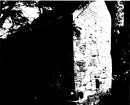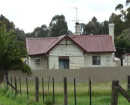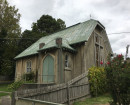GRAND TRUNK LEAD GOLD MINING CO
909 LINTON-PIGGOREET ROAD PIGGOREET, GOLDEN PLAINS SHIRE
-
Add to tour
You must log in to do that.
-
Share
-
Shortlist place
You must log in to do that.
- Download report
Statement of Significance
This record has minimal details. Please look to the right-hand-side bar for any further details about this record.
-
-
GRAND TRUNK LEAD GOLD MINING CO - History
Contextual History:History of Place:
Heritage Inventory History of Site:
GRAND TRUNK PROTECTION COMPANY
GRAND TRUNK COMPANY (name used from May 1861)
12.1860: claim is 4000 feet long and supposedly on the trunk lead formed by the various leads that proceed from Linton, Lucky Woman's, Spring Dallah on one side and Smythe's, Browne's and Italian Gully on the other; the shaft has been sited after an examination of the local geology formation along the creek.
the company has also applied for a lease of 900 yards on Scotchman's Reef; some trials on this reef have yielded 10 dwt per ton; the company has contracted for a steam engine and stamp batteries, which will be on the ground in a few days.
03.1861: the Grand Trunk shaft is down 120 feet.
04.1861: swamped out at 100 feet.
05.1861: purchased a 35 horse-power engine.
06.1861: erecting a 35 horse-power engine.
07.1861: steam engine nearly fitted up.
08.1861: nearly completed the erection of their machinery, the largest in the district.
09.1861: the engine will be working in 3 weeks.
11.1861: sinking.
12.1861: entered into a new contract for £600 to sink the shaft a further 60 feet from it present depth of 120 feet.
12.1862: swamped out; putting in pumps 15 inches in diameter
07.1863: too shallow, have been getting a little gold for about one month.
09.1863: sold its first 45 ounces of gold.
10.1863: opened out a drive at a proper level for the wash dirt.
03.1864: doing well; rich wash-dirt but the hard reef and the poorly formed drives reduce the returns; these matters will be remedied soon.
06.1864: although working under difficulties, yielded 105 ozs for the last fortnight; bottom rock is very hard at present.
09.1864:improved 100% since last quarter; yielding from 10 to 20 ozs per machine; the only draw back is the hardness of the bed rock; but that is improving the further the company drives.
12.1864: yielding over 200 ozs per week; the wash-dirt and the improved working facilities suggest that this claim will be working for along time to come; length of claim is 6320 feet of frontage.
03.1865: one of the principal mines at Springdallah; profitability is reduced because of the hard rock and the difficulties of obtaining large quantities of wash-dirt.
06.1865: yielding magnificently, regularly pays £20 per original share per fortnight; its richness and its extent make it one of the best prospects in the Ballarat district.
09.1865: getting excellent returns.
12.1865: the steadiest and best paying claim in the district; yield for the last 2 weeks of 489 ozs.
10.1860 to 12.1865: recorded production of 13,341 ozs 10 dwt 23.00 gr. (or 414.978 kg).
1865: produced £8479 worth of gold in one quarter this year, which gave £4800 in dividends; the company has 1600 shares; £140 was voted to Richard Bedford as a slight recompense for the loss of his sight in a blasting accident; towards the close of the year the mine yielded £1000 per week
03.1866:as good as ever; making good progress with their second shaft.
06.1866: excellent returns; last week's yield was 400 ozs.
09.1866: yields have fallen off; sinking a shaft at the southern end of their claim to allow them to work the 4000 feet south of their present shaft.
12.1866: weekly returns are as good as ever yet the profits to the shareholders are not as good as they used to be.
03.1867: swamped out in early January; a combined effort is being made to reduce the water in the claims at Springdallah
06.1867: new arrangements have been made with the adjoining mines to pump out the water to allow working to continue in the mines on this lead; quality of the wash dirt is good but better arrangements are needed to obtain more of the dirt.
07 .1867: recorded production of 92 ozs 7 dwt (or 2.872 kg)
09.1867: commenced to give dividends.
12.1867: yield for the quarter 1037 ozs 8 dwt; struck a rich patch recently.
1867: after restarting the average weekly yield for the year was 167 ozs.
03.1868: yield for the quarter 1226 ozs 4 dwt 15 gr.
06.1868: yield for the quarter 1470 ozs; improving in yield.
09.1868: yield for the quarter 1831 ozs 16 dwt 21 gr
12.1868: yield for the quarter 957 ozs
03.1869: yield for the quarter 1474 ozs.
10 .1867 to 06.1869: recorded production of 9,349 ozs 9 dwt 12 gr (or 290.808 kg).
09 .1869: recorded production of 278 ozs (or 8.647 kg).
12.1869: yield for the quarter 1353 ozs.
03.1870: yield for the quarter 554 ozs; an influx of water halted operations.
01 .1870 to 03.1870: recorded production of 544 ozs (or 16.921 kg).
06.1870: a new pumping plant was erected on the recently abandoned Alpha shaft and by continuous pumping the water level was eventually lowered.
12.1871: yield for the quarter 1156 ozs.
1871: average fortnightly yield for the year was 200 ozs.
03.1872: yield for the quarter 976 ozs.
06.1872: yield for the quarter 997 ozs.
31.10.1872: quarterly meeting no quorum present; yield at No. 3 poorer than ever; large stock of firewood at No.3; pumping at the Alpha discontinued, purchased air pumps; profit has been fair after paying for repairs to two boilers, rails, air pipes and new ropes; tributers have applied for a reduction of their tribute; workforce four man per shift; mine in good working order and ventilation good.
12.1872: yield for the quarter 1037 ozs.
1872: average weekly yield for the year was 80 ozs.
28.01.1873 to 11.03.1873: three tribute parties working this mine.
30.01.1873: quarterly meeting: No.1 is very profitable but the yield from No. 3 is falling off; the six man surface tribute party obtained 28 ozs 9 dwt from an extensive area of payable wash; decided not to purchase the Alpha Co.plant; furnace has been repaired there being a quantity of black sand waiting to be treated; pipes of one of the syphons have been brought to the surface and offered for sale at £15 per ton.
03.1873: yield for the quarter 864 ozs.
06.1873: yield for the quarter 782 ozs.57
12.1873: yield for the quarter 824 ozs.
10.1871 to 12.1873: recorded production of 6,636ozs (or 206.408 kg).
1873: mining ceased between the Trunk and the Lake mines; average weekly yield for the year was 55 ozs; Mr Webb advertised for fossickers for the northern end; the drives in this mine were low and disliked by the miners; due to the hardness of the bedrock the drives going south were too shallow and level was lost so that the water would not flow to the shaft; pumps worked by Chinamen were installed at points; reaching softer country to the south the lead widened out and splendid gold was obtained, making this the richest mine on the field.
06.1874: yield for the quarter 626 ozs.
09.1874: yield for the quarter 623 ozs.
12.1874: have discovered either the continuation of the Main Trunk lead or a new one; yield for the quarter 543 ozs dwt gr.62
04.1874 to 12.1874: recorded production of 1,792ozs (or 55.739 kg).
1874: average fortnightly yield for the year was 135 ozs; mine started to decline.
10.1860 to 12.1874: total recorded mine production of 996.590 kg.
30.10.1875: fossickers at No.1 found a rich quartz reef that tested at 2 oz per ton from a 3.5 ton trail; contract work has been found to be more economical than wages; water at No. 1 found to be increasing as other mines such as the Argyle cease, fortunately the water is below the present level of workings; pumps driven at 13 to 16 strokes per minute which caused the parting of the pumping rods, when they were repaired it was found that the clack was damaged; better pumps will be needed at No. 1 the present ones are 14 years old; yield for the quarter of 622 ozs 7 dwt 6 gr.
28.10.1876: quarterly report: describes the underground workings; new boiler at No. 1 shaft is 31 feet long and has eight galloway tubes; the whole of the lower level at the No. 3 shaft has been let for fossicking.
09.1877: operations suspended a few weeks ago.
1880: Mr. Dobbertain cut a water race up the creek and put in a small tunnel to get as high a stream of water as possible to treat the tailings and refuse at the mine; this has become so enlarged that in flood time all the water goes through Dobbertain’s tunnel.
1899: The Grand Trunk proved to be the richest mine on the main lead producing nearly £300,000 worth of gold; most southern mine on the main lead that paid; it worked under great difficulties there being insufficient levels. A rich quartz reef was found by this mine and was tested at 2 ozs per ton and is being tested by a new company. The Trunk Lead Co. purchased the Exchequer but this turned out to be a mistake as the wash was not payable.
1899: the Main Lead Consols was the next mine on the lead followed by the Cape Clear both were unsuccessful.
20.04.1901: operations are about to resume now that the machinery has been erected at a shaft that is 280 feet deep.
07.01.1905: along the Woady Yallock Creek a little north of the old Grand Trunk shaft gold studded boulders have been discovered; development work is being undertaken to test the reef; the Grand Trunk took out a few trial crushings a few years ago.Heritage Inventory Description
GRAND TRUNK LEAD GOLD MINING CO - Heritage Inventory Description
This site straddles the Woady Yaloak River. The main quartz wash heap is on the north side of the river. It is 45 m wide at the east end and narrows down to 10 to 15 m at the west end, and is 150 m from the east to the west side. This heap is only 1.5 m high but there are 37 lines across the top of the heap along which the wash was trucked when deposited. This is a very impressive feature. It may have been deposited in this way after retreatment in the 1880s./nThe remains of the mullock heap, some quartz wash heaps and a stone boiler setting and flue are located on the south side of the river. The mullock and quartz wash heaps on this side of the river have been disturbed, primarily by a track which runs through the main mullock heap. The mullock covers an area 40 m by 30 m and is 3.5 m high, the track that has cut through the heap is included within this area. The disturbed quartz wash heaps on the south of the river covers an area 25 m by 20 m. The mullock and quartz wash heaps run east west along the bank of the river. A rock walled boiler setting 6.7 m by 2.9 m is located above the quartz wash heaps. A stone flue takes off from the west end of the setting then runs south up the slope to a stone chimney base. The brick and basalt rock remains of the chimney are scattered next to the chimney base. There is also a flattened site of a building 5 m by 3 m on the slope immediately west of the lower end of the flue./n
Heritatge Inventory Significance:
Heritage Inventory Site Features: There were a couple of mounting bolts among the quartz wash at the east end of the mullock heap. Further research/investigation of this part of the site might provide some information about the operation of the mine.
-
-
-
-
-
NORTH PORT ARTHUR CO
 Victorian Heritage Inventory
Victorian Heritage Inventory -
ALPHA CO
 Victorian Heritage Inventory
Victorian Heritage Inventory -
SOUTH PORT ARTHUR CO
 Victorian Heritage Inventory
Victorian Heritage Inventory
-
-






